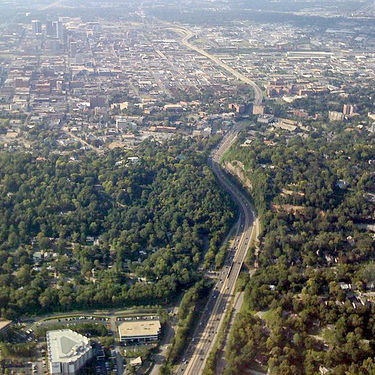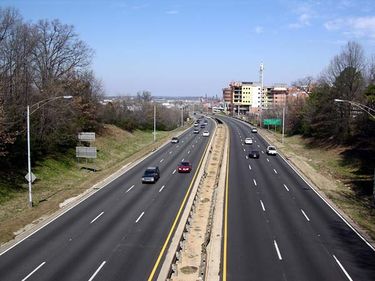Elton B. Stephens Expressway
The Elton B. Stephens Expressway, more commonly referred to locally as the Red Mountain Expressway, is a limited access freeway serving as a north-south connection between Homewood and Mountain Brook south of Red Mountain with I-20/I-59 just to the northeast of downtown Birmingham. It was named for local businessman and philanthropist Elton B. Stephens, who chaired the Birmingham and Jefferson County Freeway and Expressway Committee. The expressway was largely built over the former path of 26th Street North and South.
The freeway generally carries three lanes for travel in each direction and carries traffic for both U. S. Highway 31 and U. S. Highway 280. Between its northern terminus and University Boulevard, the freeway is elevated. From University Boulevard to its southern terminus the freeway is by and large at-grade.
Termini
The southern terminus of the expressway is where Highway 31 and Highway 280 split in Homewood at Rosedale Drive. From this point Highway 31 becomes Montgomery Highway and continues in a southerly direction through Homewood, Vestavia Hills, Hoover and points beyond as it exits the Birmingham region. Highway 280 remains as a divided highway as it travels in a southeasterly direction through Mountain Brook, Vestavia Hills, Hoover, Calera and points beyond as it exits the Birmingham region.
At its northern terminus, Highway 280 arrives at its western terminus, whilst Highway 31 continues as Carraway Boulevard through Birmingham and continues its northerly track through Fultondale, Gardendale, Morris, Kimberly, and Warrior and points beyond as it exits the Birmingham region.
History
Construction commenced in 1962 with the initial blasting of the Red Mountain cut and construction of the interchange with Florida Short Route. The latter work was delayed by intransigence from the Jefferson County Board of Education, which denied crews access to the Shades Valley High School campus until the Department of Transportation secured replacement land for that condemned for highway use.
The Highland Avenue overpass was completed in January 1967. The cut was completed later that same year, with the highway opening in 1970.
Originally ending at 2nd Avenue North, its connection with I-20/I-59 and Carraway Boulevard was completed in the 1980s over the site of Birmingham’s grand Terminal Station demolished in 1969.
When the expressway was originally constructed, a cloverleaf exit was constructed at 1st Avenue North for southbound traffic. An on-ramp was constructed over the cloverleaf and used in the 1970s, but later removed. Currently, although the cloverleaf exit exists, it is closed to traffic.
In the months leading to 1996 Olympic soccer to be hosted in Legion Field, the Olympic soccer countdown clock was located on the Highland Avenue overpass.
Exit Listing
| Northbound Exit | Number of Lanes | Southbound Exit | Number of Lanes |
|---|---|---|---|
| Rosedale Drive | 2 | U.S. Highway 78/3rd Avenue South/4th Avenue South | 3 |
| Highland Avenue/Arlington Avenue | 3 | University Boulevard | 3 |
| University Boulevard | 4 | 21st Avenue South/Vulcan Park | 3 |
| U.S. Highway 78/3rd Avenue South/4th Avenue South | 3 | Highway 31 South | 4 |
| Highway 11/1st Avenue North | 3 | Mountain Brook/Birmingham Zoo | 4 |
| 2nd Avenue North | 4 | ||
| Carraway Boulevard/I-20/I-59 | 4 |
External links
- Elton B. Stephens Expressway - North at AARoads.com
- Elton B. Stephens Expressway - South at AARoads.com
| U. S. Highway 31 in Birmingham | ||
|---|---|---|
| North side | South side | |
| Current route | Carraway Blvd · Elton B. Stephens Expressway | Elton B. Stephens Expressway |
| Previous routes | 8th Avenue N · 24th Street N | 24th Street S · 7th Avenue S · 20th Street S · 21st Street S |

